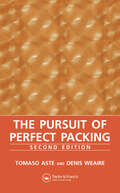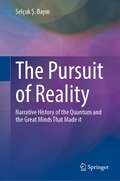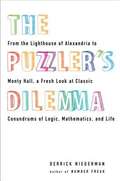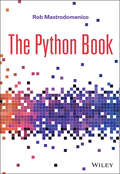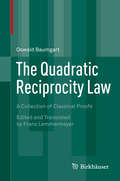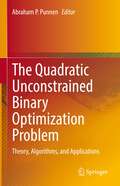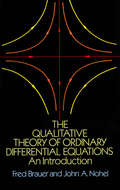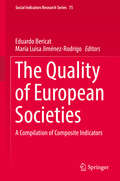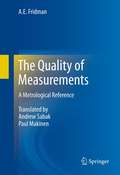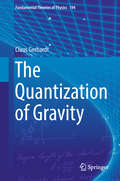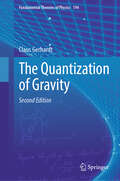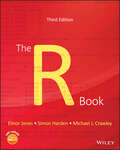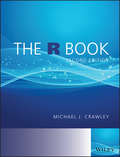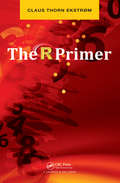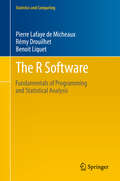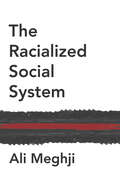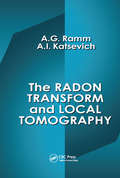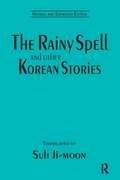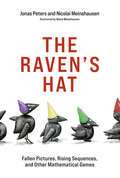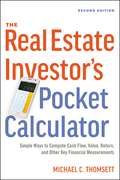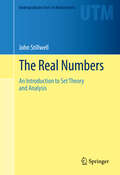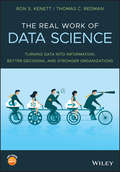- Table View
- List View
The Pursuit of Perfect Packing
by Tomaso Aste Denis WeaireCoauthored by one of the creators of the most efficient space packing solution, the Weaire-Phelan structure, The Pursuit of Perfect Packing, Second Edition explores a problem of importance in physics, mathematics, chemistry, biology, and engineering: the packing of structures. Maintaining its mathematical core, this edition continues and rev
The Pursuit of Reality: Narrative History of the Quantum and the Great Minds That Made it
by Selçuk Ş. BayınIn a highly accessible style, this book presents a narrative history of the quantum theory with the new developments that intrigue all inquisitive minds. Quantum theory is counter-intuitive and sometimes downright weird. Even Nobel Laureate physicists like Richard Feynman admit that they do not understand it. Yet, so far, there is not a shred of experimental data that conflicts with its predictions. Its effect on our lives is bound to increase with the quantum information era ushered in by the great Bohr–Einstein debate. Tantalizing applications of quantum information like teleportation, spy-proof communication, super-fast quantum computers, and more are going to influence our lives and change our beliefs about the nature of physical reality. This book takes the reader on an exhilarating journey through the intellectual history of quantum that is turning out to be more surprising every day.
The Puzzler's Dilemma: From the Lighthouse of Alexandria to Monty Hall, a Fresh Look at Classic Conundrums of Logic, Mathematics, and Life
by Derrick NiedermanCalling all puzzlers. . . From mathematics to word puzzles, from logic to lateral thinking, veteran puzzle maker Derrick Niederman delights in tackling the trickiest brainteasers in a new way. Among the old chestnuts he cracks wide open are the following classics: Knights and knaves The monk and the mountain The dominoes and the chessboard The unexpected hanging The Tower of Hanoi Using real-world analogies, infectious humor, and a fresh approach, this deceptively simple volume will challenge, amuse, enlighten, and surprise even the most experienced puzzle solver.
The Pythagorean World
by Jane McdonnellThis book explores precisely how mathematics allows us to model and predict the behaviour of physical systems, to an amazing degree of accuracy. One of the oldest explanations for this is that, in some profound way, the structure of the world is mathematical. The ancient Pythagoreans stated that "everything is number". However, while exploring the Pythagorean method, this book chooses to add a second principle of the universe: the mind. This work defends the proposition that mind and mathematical structure are the grounds of reality.
The Python Book
by Rob MastrodomenicoThe Python Book Discover the power of one of the fastest growing programming languages in the world with this insightful new resource The Python Book delivers an essential introductory guide to learning Python for anyone who works with data but does not have experience in programming. The author, an experienced data scientist and Python programmer, shows readers how to use Python for data analysis, exploration, cleaning, and wrangling. Readers will learn what in the Python language is important for data analysis, and why. The Python Book offers readers a thorough and comprehensive introduction to Python that is both simple enough to be ideal for a novice programmer, yet robust to be useful for those more experienced in the language. The book assists budding programmers to gradually increase their skills as they move through the book, always with an understanding of what they are covering and why it is useful. Used by major companies like Google, Facebook, Instagram, Spotify, and more, Python promises to remain central to the programming landscape for years to come. Containing a thorough discussion of Python programming topics like variables, equalities and comparisons, tuple and dictionary data types, while and for loops, and if statements, readers will also learn: How to use highly useful Python programming libraries, including Pandas and Matplotlib How to write Python functions and classes How to write and use Python scripts To deal with different data types within Python Perfect for statisticians, computer scientists, software programmers, and practitioners working in private industry and medicine, The Python Book will also be of interest to students in any of the aforementioned fields. As it assumes no programming experience or knowledge, the book is ideal for those who work with data and want to learn to use Python to enhance their work. <P><P><i>Advisory: Bookshare has learned that this book offers only partial accessibility. We have kept it in the collection because it is useful for some of our members. Benetech is actively working on projects to improve accessibility issues such as these.</i>
The Quadratic Reciprocity Law
by Oswald BaumgartThis book is the English translation of Baumgart's thesis on the early proofs of the quadratic reciprocity law ("Über das quadratische Reciprocitätsgesetz. Eine vergleichende Darstellung der Beweise"), first published in 1885. It is divided into two parts. The first part presents a very brief history of the development of number theory up to Legendre, as well as detailed descriptions of several early proofs of the quadratic reciprocity law. The second part highlights Baumgart's comparisons of the principles behind these proofs. A current list of all known proofs of the quadratic reciprocity law, with complete references, is provided in the appendix. This book will appeal to all readers interested in elementary number theory and the history of number theory.
The Quadratic Unconstrained Binary Optimization Problem: Theory, Algorithms, and Applications
by Abraham P. PunnenThe quadratic binary optimization problem (QUBO) is a versatile combinatorial optimization model with a variety of applications and rich theoretical properties. Application areas of the model include finance, cluster analysis, traffic management, machine scheduling, VLSI physical design, physics, quantum computing, engineering, and medicine. In addition, various mathematical optimization models can be reformulated as a QUBO, including the resource constrained assignment problem, set partitioning problem, maximum cut problem, quadratic assignment problem, the bipartite unconstrained binary optimization problem, among others.This book presents a systematic development of theory, algorithms, and applications of QUBO. It offers a comprehensive treatment of QUBO from various viewpoints, including a historical introduction along with an in-depth discussion of applications modelling, complexity and polynomially solvable special cases, exact and heuristic algorithms, analysis of approximation algorithms, metaheuristics, polyhedral structure, probabilistic analysis, persistencies, and related topics. Available software for solving QUBO is also introduced, including public domain, commercial, as well as quantum computing based codes.
The Qualitative Theory of Ordinary Differential Equations: An Introduction
by John A. Nohel Fred Brauer"This is a very good book ... with many well-chosen examples and illustrations." -- American Mathematical MonthlyThis highly regarded text presents a self-contained introduction to some important aspects of modern qualitative theory for ordinary differential equations. It is accessible to any student of physical sciences, mathematics or engineering who has a good knowledge of calculus and of the elements of linear algebra. In addition, algebraic results are stated as needed; the less familiar ones are proved either in the text or in appendixes.The topics covered in the first three chapters are the standard theorems concerning linear systems, existence and uniqueness of solutions, and dependence on parameters. The next three chapters, the heart of the book, deal with stability theory and some applications, such as oscillation phenomena, self-excited oscillations and the regulator problem of Lurie.One of the special features of this work is its abundance of exercises-routine computations, completions of mathematical arguments, extensions of theorems and applications to physical problems. Moreover, they are found in the body of the text where they naturally occur, offering students substantial aid in understanding the ideas and concepts discussed. The level is intended for students ranging from juniors to first-year graduate students in mathematics, physics or engineering; however, the book is also ideal for a one-semester undergraduate course in ordinary differential equations, or for engineers in need of a course in state space methods.
The Quality of European Societies: A Compilation of Composite Indicators (Social Indicators Research Series #75)
by Eduardo Bericat María Luisa Jiménez-RodrigoThis volume presents a compilation of composite indicators created in order to measure important aspects of the quality of European societies. It examines three main questions: do Europeans live in good societies and enjoy good lives; are European societies becoming better as time passes, or is their quality slowly deteriorating; is the quality of life of Europe’s citizens improving over time or is it gradually and irrecoverably getting worse. The volume uses a precise and rigorous system of information to answer these questions and to assess the current situation and monitor the quality of European societies. It describes and discusses fourteen key domains, and per chapter, presents five rankings of EU countries based on composite indicators, which are used as one of the best instruments social science has to synthesize a large amount of information, and they are especially well suited to measure multidimensional social phenomena. The new System of Indices on the Quality of European Societies (SIQES) presented in this volume offers a very broad and rich empirical overview of more than 70 social composite indicators and their nearly 300 dimensions. One of the key findings coming out from the SIQES is that, according to the societal quality of European countries, there exist five different “Europes” inside Europe.
The Quality of Measurements
by Paul Makinen A. E. Fridman Andrew SabakThis monograph and translation from the Russian describes in detail and comments on the fundamentals of metrology. The basic concepts of metrology, the principles of the International System of Units SI, the theory of measurement uncertainty, the new methodology of estimation of measurement accuracy on the basis of the uncertainty concept, as well as the methods for processing measurement results and estimating their uncertainty are discussed from the modern position. It is shown that the uncertainty concept is compatible with the classical theory of accuracy. The theory of random uncertainties is supplemented with their most general description on the basis of generalized normal distribution; the instrumental systematic errors are presented in connection with the methodology of normalization of the metrological characteristics of measuring instruments. The information about modern systems of traceability is given. All discussed theoretical principles and calculation methods are illustrated with examples.
The Quantization of Gravity (Fundamental Theories of Physics #194)
by Claus GerhardtA unified quantum theory incorporating the four fundamental forces of nature is one of the major open problems in physics. The Standard Model combines electro-magnetism, the strong force and the weak force, but ignores gravity. The quantization of gravity is therefore a necessary first step to achieve a unified quantum theory. In this monograph a canonical quantization of gravity has been achieved by quantizing a geometric evolution equation resulting in a gravitational wave equation in a globally hyperbolic spacetime. Applying the technique of separation of variables we obtain eigenvalue problems for temporal and spatial self-adjoint operators where the temporal operator has a pure point spectrum with eigenvalues $\lambda_i$ and related eigenfunctions, while, for the spatial operator, it is possible to find corresponding eigendistributions for each of the eigenvalues $\lambda_i$, if the Cauchy hypersurface is asymptotically Euclidean or if the quantized spacetime is a black hole with a negative cosmological constant. The hyperbolic equation then has a sequence of smooth solutions which are products of temporal eigenfunctions and spatial eigendistributions. Due to this "spectral resolution" of the wave equation quantum statistics can also be applied to the quantized systems. These quantum statistical results could help to explain the nature of dark matter and dark energy.
The Quantization of Gravity (Fundamental Theories of Physics #194)
by Claus GerhardtA unified quantum theory incorporating the four fundamental forces of nature is one of the major open problems in physics. The Standard Model combines electro-magnetism, the strong force and the weak force, but ignores gravity. The quantization of gravity is therefore a necessary first step to achieve a unified quantum theory. In this monograph a canonical quantization of gravity has been achieved by quantizing a geometric evolution equation resulting in a hyperbolic equation in a fiber bundle, where the base space represents a Cauchy hypersurface of the quantized spacetime and the fibers the Riemannian metrics in the base space. The hyperbolic operator, a second order partial differential operator, acts both in the fibers as well as in the base space. In this second edition new results are presented which allow the solutions of the hyperbolic equation to be expressed as products of spatial and temporal eigenfunctions of self-adjoint operators. These eigenfunctions form complete bases in appropriate Hilbert spaces. The eigenfunctions depending on the fiber elements are a subset of the Fourier kernel of the symmetric space SL(n,R)/SO(n), where n is the dimension of the base space; they represent the elementary gravitons corresponding to the degrees of freedom in choosing the entries of Riemannian metrics with determinants equal to one. These are all the degrees of freedom available because of the coordinate system invariance: For any smooth Riemannian metric there exists an atlas such that in each chart the determinant of the metric is equal to one. In the important case n=3 the Standard Model could also be incorporated such that one can speak of a unified quantization of all four fundamental forces of nature.
The R Book
by Michael J. Crawley Elinor Jones Simon HardenA start-to-finish guide to one of the most useful programming languages for researchers in a variety of fields In the newly revised Third Edition of The R Book, a team of distinguished teachers and researchers delivers a user-friendly and comprehensive discussion of foundational and advanced topics in the R software language, which is used widely in science, engineering, medicine, economics, and other fields. The book is designed to be used as both a complete text—readable from cover to cover—and as a reference manual for practitioners seeking authoritative guidance on particular topics. This latest edition offers instruction on the use of the RStudio GUI, an easy-to-use environment for those new to R. It provides readers with a complete walkthrough of the R language, beginning at a point that assumes no prior knowledge of R and very little previous knowledge of statistics. Readers will also find: A thorough introduction to fundamental concepts in statistics and step-by-step roadmaps to their implementation in R; Comprehensive explorations of worked examples in R; A complementary companion website with downloadable datasets that are used in the book; In-depth examination of essential R packages. Perfect for undergraduate and postgraduate students of science, engineering, medicine economics, and geography, The R Book will also earn a place in the libraries of social sciences professionals.
The R Book
by Michael J. CrawleyHugely successful and popular text presenting an extensive and comprehensive guide for all R users The R language is recognized as one of the most powerful and flexible statistical software packages, enabling users to apply many statistical techniques that would be impossible without such software to help implement such large data sets. R has become an essential tool for understanding and carrying out research.This edition:Features full colour text and extensive graphics throughout.Introduces a clear structure with numbered section headings to help readers locate information more efficiently.Looks at the evolution of R over the past five years.Features a new chapter on Bayesian Analysis and Meta-Analysis.Presents a fully revised and updated bibliography and reference section.Is supported by an accompanying website allowing examples from the text to be run by the user. Praise for the first edition:'...if you are an R user or wannabe R user, this text is the one that should be on your shelf. The breadth of topics covered is unsurpassed when it comes to texts on data analysis in R.' (The American Statistician, August 2008)'The High-level software language of R is setting standards in quantitative analysis. And now anybody can get to grips with it thanks to The R Book...' (Professional Pensions, July 2007)
The R Primer
by Claus Thorn EkstromNewcomers to R are often intimidated by the command-line interface, the vast number of functions and packages, or the processes of importing data and performing a simple statistical analysis. The R Primer provides a collection of concise examples and solutions to R problems frequently encountered by new users of this statistical software.Rather tha
The R Software
by Pierre Lafaye de Micheaux Rémy Drouilhet Benoit LiquetThe contents of The R Software are presented so as to be both comprehensive and easy for the reader to use. Besides its application as a self-learning text, this book can support lectures on R at any level from beginner to advanced. This book can serve as a textbook on R for beginners as well as more advanced users, working on Windows, MacOs or Linux OSes. The first part of the book deals with the heart of the R language and its fundamental concepts, including data organization, import and export, various manipulations, documentation, plots, programming and maintenance. The last chapter in this part deals with oriented object programming as well as interfacing R with C/C++ or Fortran, and contains a section on debugging techniques. This is followed by the second part of the book, which provides detailed explanations on how to perform many standard statistical analyses, mainly in the Biostatistics field. Topics from mathematical and statistical settings that are included are matrix operations, integration, optimization, descriptive statistics, simulations, confidence intervals and hypothesis testing, simple and multiple linear regression, and analysis of variance. Each statistical chapter in the second part relies on one or more real biomedical data sets, kindly made available by the Bordeaux School of Public Health (Institut de Santé Publique, d'Épidémiologie et de Développement - ISPED) and described at the beginning of the book. Each chapter ends with an assessment section: memorandum of most important terms, followed by a section of theoretical exercises (to be done on paper), which can be used as questions for a test. Moreover, worksheets enable the reader to check his new abilities in R. Solutions to all exercises and worksheets are included in this book.
The Racialized Social System: Critical Race Theory as Social Theory
by Ali MeghjiFar from its origins in US legal studies in the 1980s, critical race theory has grown to become a leading approach to the analysis of racial inequality around the world. It has courted much controversy along the way, often misunderstood and poorly defined. So what precisely is critical race theory and what makes it different from other theories of race, racialization and racism? In this incisive book, Ali Meghji defines the contours of critical race theory through the notion of the 'racialized social system'. He thereby excavates a solid social theory that clears up many empirical and conceptual questions that continue to surface, offering a flexible, practical model for studying structural racism. In making his case, Meghji pays attention to the multiple dimensions of the racialized social system, focusing on core phenomena such as interaction orders, material interests, ideologies, emotions, and organizations. In a context where any work mentioning 'race' gets defined as critical race theory, this book expounds an approach that promises to be more generative for the social scientific study of race.
The Rademacher System in Function Spaces
by Sergey V. AstashkinThis book presents a systematic treatment of the Rademacher system, one of the most important unifying concepts in mathematics, and includes a number of recent important and beautiful results related to the Rademacher functions. The book discusses the relationship between the properties of the Rademacher system and geometry of some function spaces. It consists of three parts, in which this system is considered respectively in Lp-spaces, in general symmetric spaces and in certain classes of non-symmetric spaces (BMO, Paley, Cesaro, Morrey). The presentation is clear and transparent, providing all main results with detailed proofs. Moreover, literary and historical comments are given at the end of each chapter. This book will be suitable for graduate students and researchers interested in functional analysis, theory of functions and geometry of Banach spaces.
The Radon Transform and Local Tomography
by Alexander G. Ramm Alex I. KatsevichOver the past decade, the field of image processing has made tremendous advances. One type of image processing that is currently of particular interest is "tomographic imaging," a technique for computing the density function of a body, or discontinuity surfaces of this function. Today, tomography is widely used, and has applications in such fields as medicine, engineering, physics, geophysics, and security. The Radon Transform and Local Tomography clearly explains the theoretical, computational, and practical aspects of applied tomography. It includes sufficient background information to make it essentially self-contained for most readers.
The Rainy Spell and Other Korean Stories
by Ji-moon SuhThis anthology of short stories reflects the writers' shared core experience of Korea's trajectory from an inward-looking feudal state, through Japanese colony and battle-ground for the Korean War, to a modernizing society. Three stories have been added to the original edition.
The Random Matrix Theory of the Classical Compact Groups (Cambridge Tracts in Mathematics #218)
by Elizabeth S. MeckesThis is the first book to provide a comprehensive overview of foundational results and recent progress in the study of random matrices from the classical compact groups, drawing on the subject's deep connections to geometry, analysis, algebra, physics, and statistics. The book sets a foundation with an introduction to the groups themselves and six different constructions of Haar measure. Classical and recent results are then presented in a digested, accessible form, including the following: results on the joint distributions of the entries; an extensive treatment of eigenvalue distributions, including the Weyl integration formula, moment formulae, and limit theorems and large deviations for the spectral measures; concentration of measure with applications both within random matrix theory and in high dimensional geometry; and results on characteristic polynomials with connections to the Riemann zeta function. This book will be a useful reference for researchers and an accessible introduction for students in related fields.
The Raven's Hat: Fallen Pictures, Rising Sequences, and Other Mathematical Games
by Jonas Peters Nicolai MeinshausenGames that show how mathematics can solve the apparently unsolvable.This book presents a series of engaging games that seem unsolvable--but can be solved when they are translated into mathematical terms. How can players find their ID cards when the cards are distributed randomly among twenty boxes? By applying the theory of permutations. How can a player guess the color of her own hat when she can only see other players' hats? Hamming codes, which are used in communication technologies. Like magic, mathematics solves the apparently unsolvable. The games allow readers, including university students or anyone with high school-level math, to experience the joy of mathematical discovery.
The Real Estate Investor's Pocket Calculator: Simple Ways to Compute Cash Flow, Value, Return, and Other Key Financial Measurements
by Michael ThomsettThe return on real estate investments hinges less on the physical property and more on the math. This invaluable resource helps you analyze the financial picture before shoveling out the money.With real estate investing on the rebound, more people are jumping into the market, although not everyone is finding equal amounts of success. Why do some investments turn into gold mines and some into money pits? If they had taken the right measures beforehand, they would&’ve realized that the numbers just didn&’t add up.Before your next real estate investment, you need to ask things like: Have you measured every component of value, such as cash flow, income taxes, financing, and investment yield? Do you know which calculations to use on specific properties? Have you weighed all the risks?In The Real Estate Investor&’s Pocket Calculator, finance expert and author Michael C. Thomsett shows you how to:Gauge supply and demandProject return on investment and equityAnalyze present and future valueCalculate cash flowMake accurate tax projectionsFewer mistakes and less guess work. Larger returns and even more opportunities for additional investments. It&’s all possible now with the help of The Real Estate Investor&’s Pocket Calculator!
The Real Numbers
by John StillwellWhile most texts on real analysis are content to assume the real numbers, or to treat them only briefly, this text makes a serious study of the real number system and the issues it brings to light. Analysis needs the real numbers to model the line, and to support the concepts of continuity and measure. But these seemingly simple requirements lead to deep issues of set theory--uncountability, the axiom of choice, and large cardinals. In fact, virtually all the concepts of infinite set theory are needed for a proper understanding of the real numbers, and hence of analysis itself. By focusing on the set-theoretic aspects of analysis, this text makes the best of two worlds: it combines a down-to-earth introduction to set theory with an exposition of the essence of analysis--the study of infinite processes on the real numbers. It is intended for senior undergraduates, but it will also be attractive to graduate students and professional mathematicians who, until now, have been content to "assume" the real numbers. Its prerequisites are calculus and basic mathematics. Mathematical history is woven into the text, explaining how the concepts of real number and infinity developed to meet the needs of analysis from ancient times to the late twentieth century. This rich presentation of history, along with a background of proofs, examples, exercises, and explanatory remarks, will help motivate the reader. The material covered includes classic topics from both set theory and real analysis courses, such as countable and uncountable sets, countable ordinals, the continuum problem, the Cantor-Schröder-Bernstein theorem, continuous functions, uniform convergence, Zorn's lemma, Borel sets, Baire functions, Lebesgue measure, and Riemann integrable functions.
The Real Work of Data Science: Turning data into information, better decisions, and stronger organizations
by Thomas C. Redman Ron S. KenettThe essential guide for data scientists and for leaders who must get more from their data science teams The Economist boldly claims that data are now "the world's most valuable resource." But, as Kenett and Redman so richly describe, unlocking that value requires far more than technical excellence. The Real Work of Data Science explores understanding the problems, dealing with quality issues, building trust with decision makers, putting data science teams in the right organizational spots, and helping companies become data-driven. This is the work that spells the difference between a good data scientist and a great one, between a team that makes marginal contributions and one that drives the business, between a company that gains some value from its data and one in which data truly is "the most valuable resource." "These two authors are world-class experts on analytics, data management, and data quality; they've forgotten more about these topics than most of us will ever know. Their book is pragmatic, understandable, and focused on what really counts. If you want to do data science in any capacity, you need to read it."—Thomas H. Davenport, Distinguished Professor, Babson College and Fellow, MIT Initiative on the Digital Economy "I like your book. The chapters address problems that have faced statisticians for generations, updated to reflect today's issues, such as computational Big Data."—Sir David Cox, Warden of Nuffield College and Professor of Statistics, Oxford University "Data science is critical for competitiveness, for good government, for correct decisions. But what is data science? Kenett and Redman give, by far, the best introduction to the subject I have seen anywhere. They address the critical questions of formulating the right problem, collecting the right data, doing the right analyses, making the right decisions, and measuring the actual impact of the decisions. This book should become required reading in statistics and computer science departments, business schools, analytics institutes and, most importantly, by all business managers." —A. Blanton Godfrey, Joseph D. Moore Distinguished University Professor, Wilson College of Textiles, North Carolina State University
